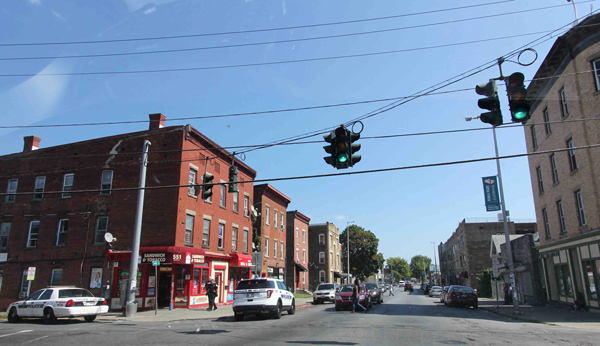ABOVE: Portable library set up by The Uni Project called the “Ozone Park Plaza,” located on the border between Brooklyn and Queens. (Image Credit: The Uni Project)
Lee Altman | February 10, 2016
Lee Altman is an adjunct professor at Columbia University’s Graduate School of Architecture, Planning, and Preservation, and until recently was an Urban Designer for the NYC Department of Design and Construction. She focuses on developing design strategies and processes that improve public health.

New York City did something transformative 5 years ago. After years of conferences, discussions, meetings and deliberations, it issued a guidebook which explained and illustrated in very clear terms how we can (and must) use design to promote public health. The Active Design Guidelines were groundbreaking not only because of what was in them, but also because of how they came to be. This was a collaboration of architects, planners, and urban designers, health professionals and researchers, private, public, and non-profit groups, who all had to find a common language. The language part is critical. It’s hard to imagine how embedded we all are in our professional jargon until we try to convey complex notions to someone from a different field, who may use the same terms to mean something completely different. Terms that are the basic building blocks of our practice like model, research, plan, have to be redefined. For two fields, design and health, which both rely on rigorous training and require the development of critical systems thinking and flexible methodologies, having to reconsider our language can be challenging. However, it does start a process of questioning and reevaluating our most basic assumptions.
Since the Active Design Guidelines were published, the City has used various policies and initiatives to implement them, which required a lot of collaboration between different City Agencies. The design of housing, parks, transportation, and public buildings are implemented by different agencies and follow different processes and funding streams; not to mention large scale planning and design projects that try to address housing affordability, coastal resiliency, and economic development. In the sandbox of City Agencies some play well with others and some less so, but prioritizing health does tend to ring true for many.

A number of supplemental documents were issued, focusing on affordable housing and sidewalk and street design, trying to further codify a complex process by highlighting best practices or offering step-by-step instructions. This is where the Active Design Guidelines, or any type of guideline and best practice, fall short. The specificity of place, of neighborhood, community, and user group – the people and characteristics that differentiate one neighborhood from another – cannot all be accounted for. And if we cannot account for the diversity within one city (granted, New York sets a very high bar on that one), how can we account for the differences between cities? Regions? Countries?
Suffice to look a few miles up the Hudson River to cities like Poughkeepsie and Newburgh, struggling with high crime rates and vacancies in addition to the now-ubiquitous chronic health challenges, to raise questions around the value or even relevance of wider sidewalks, bike paths, inviting staircases, and other Active Design strategies. Does this mean that design becomes a luxury, only to be afforded once the “real” problems are solved? Absolutely not. But it does mean that design on its own is not enough. This is where the methodology used to develop the Active Design Guidelines becomes more important than the Guidelines themselves. The process of collaboration that requires different fields to come to the table, suspend their most basic assumptions and develop a new language, rethinking and rejiggering known solutions. The missing piece in the Active Design puzzle is the local voice. Transforming places can only be sustained when developed with the people who will inhabit them, with a shared sense of ownership, responsibility, and accountability. This extends not only to community groups and activists but also to all others who will bear the lesser-known, not-so-sexy burden of operations and continued maintenance, from sanitation workers to law enforcement. It is time for the collaboration between the health and design disciplines to recognize the critical role that citizens play in shaping their own neighborhoods, health, and future, and invite them to the table. Several New York City initiatives such as the Department of Transportation’s Plaza Program and the Department of Health’s District Public Health Offices have been charting the course, making local priorities and partnerships key to their work. Without this type of participation applying guidelines and best practices, even ones as thoughtful and carefully crafted as the Active Design Guidelines, will not result in sustained impact.
